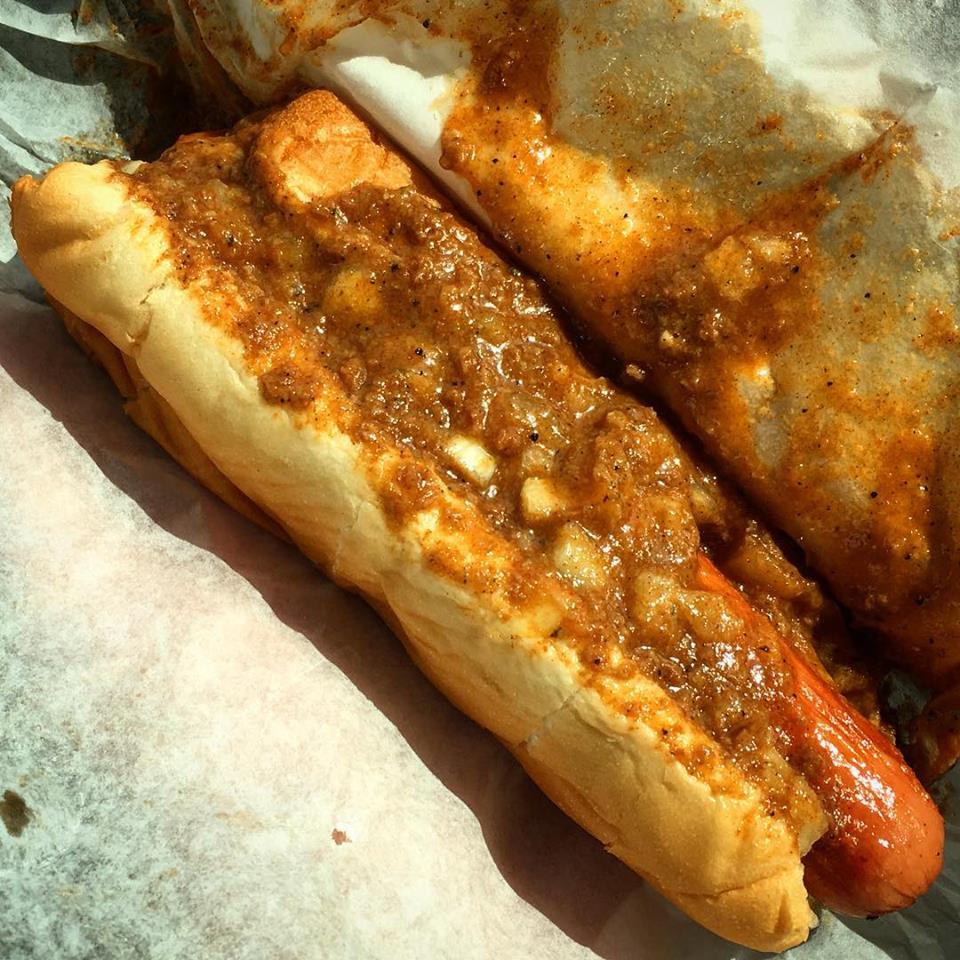 By Steve Cichon
By Steve Cichon
steve@buffalostories.com
@stevebuffalo
There are few things we consider more American — and relish with more Buffalove — than the hot dog, especially on a nice summer afternoon. But that wasn’t always the case.

Ted’s, with Peace Bridge railing overhead. (Buffalo Stories archives)
Around the same time Ted Liaros was opening his first red hot shack under the Peace Bridge, Mayor Frank X. Schwab was working to rid Buffalo’s streets of what he saw as the great wiener menace.
Schwab, Buffalo’s brewer mayor — who was convicted of violating Prohibition laws while in office — thought beer was OK, but the frankfurter should be banished. In 1922, he fought for and won the right to license and regulate the city’s growing number of hot dog stands with the notion to close them down, threatening to “arrest any hot dog merchant who held forth in the streets.”
It wasn’t the hot dog itself as much as the apparent willingness of hucksters to set up almost anywhere without regard to surroundings or sanitation.
A few years later, state leaders declared Buffalo’s roadside hot dogs stands “a menace to public health,” especially with regards to the keeping and selling of milk products without any proper way to stop spoilage. Dr. Edward Clark of the state health department called the red hot emporium “an institution which must be brought under special state control.”
One vendor on South Division Street was proud of his stand, and bragging of cleanliness with each patron’s “loaf of bread, hunk of meat, and smear of mustard.” The crackdown was welcomed by the owners of clean stands. “Every effort is made,” said another frankfurter hut owner, “to keep the quality of the rolls and the wieners.”
Buffalo and hot dogs were a natural marriage. For decades, Buffalo had been one of America’s leading meat packing cities, and many of the great names in meat processing have been great names in the fight to fill Buffalo’s hot dog buns.
At one point, the Dold name was tops with “wiener sausage.” The Jacob Dold Packing Company was Buffalo’s largest at the turn of the century, even having a display at the Pan-Am Exposition showcasing “the art of curing meats.” Dold sold out to Hygrade in 1938.

Buffalo News archives
Frank Wardynski came to Buffalo from Poland in 1915, and soon after started running a butcher shop on Peckham Street in the shadow of St. Stanislaus Church in the heart of Polonia. In 1979, Wardy’s turning out three million pounds of sausage a year. Today, the company is run by third generation ownership, which also bought the rights to use the name Shelly Meats. The cold cuts and sausages of A. Szelagowski & Sons were Buffalo’s favorite for decades.

Shelly Meats, 1983 (Buffalo News atchives)
Coming to Buffalo in the same wave of Polish immigration that brought rival Wardynski here, Joseph Malecki was a butcher in Opatowek, Poland, when he came to Buffalo in 1914. His children, Ronald and Virginia, were selling $2 million of Malecki’s Polka Brand Sausages by 1963. After 73 years of East Side sausage making, Malecki Meats closed its doors in 1988, leaving many lovers of their links heartbroken.

Buffalo Stories archives
As the word of Malecki’s demise spread, countless Western New Yorkers made a trek to Ted’s for one last dog.

Malecki baloney. (Buffalo News archives)
“This is a big shock to me and to all of us who work here,” Ted’s manager Marc Candino told The News days before the Malecki dogs dried up. “We’re still using Malecki. We expect our last shipment Monday, which means you can only get a Malecki dog here until Tuesday… with maybe a couple left over for Wednesday.”

Ted’s served Malecki’s hot dogs until the day the Malecki plant closed down in 1988. (Buffalo Stories archives)
Ted’s now serves what is the undisputed king of hot dogs in Western New York, direct from the Sahlen’s smokehouse. The Sahlen family has been processing meat and meat products for Buffalonians since 1869, and has been selling hot dogs since they started to be popular around the turn of the century.

Inspecting a Sahlen’s smokehouse hot dog, 1977. (Buffalo News archives)
In 1994, Sahlen’s was bringing in $17 million in sales — about 60 percent of which was in wieners. They were cranking out about 40 million hot dogs a year, good for 70 percent of the Buffalo hot dog market.
“Sahlen’s has always been Buffalo’s hot dog, and will always be, in my opinion,” Mark Battistoni, sales manager of Sahlen Packing Co. told The News in 2012. “We have a (143)-year history and commitment to the community.”
 By Steve Cichon
By Steve Cichon

















